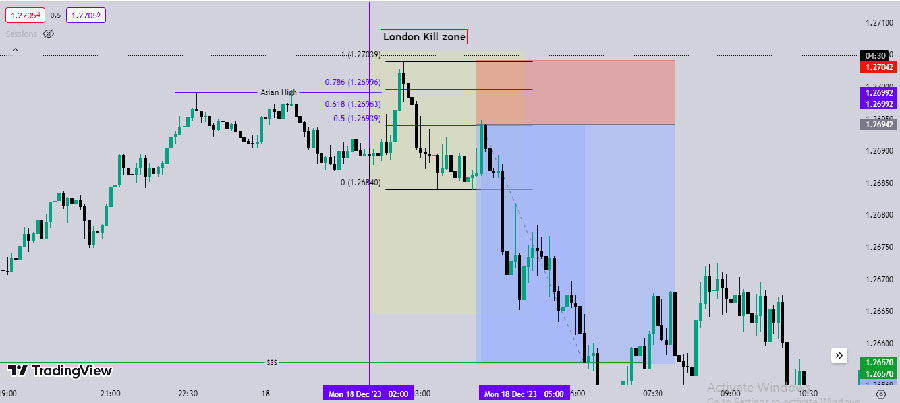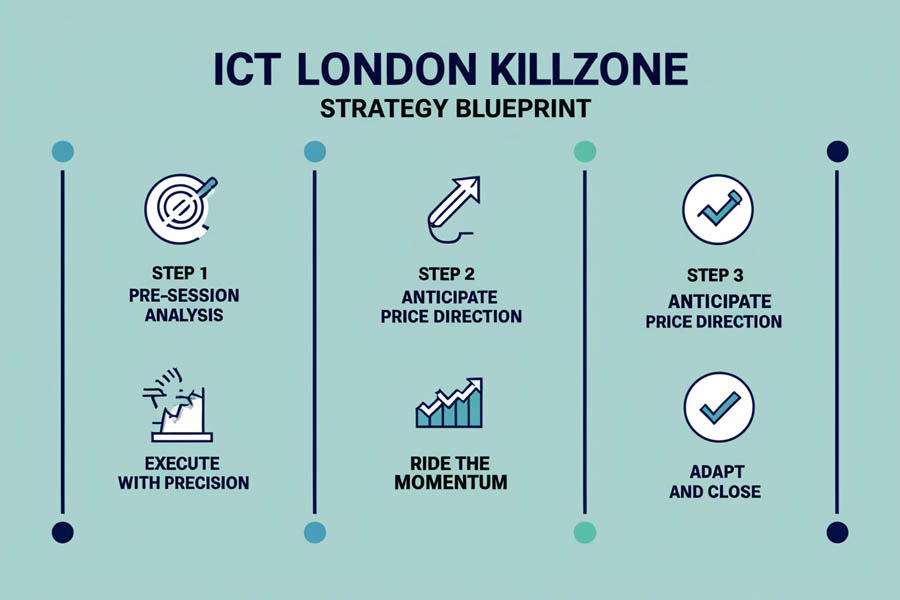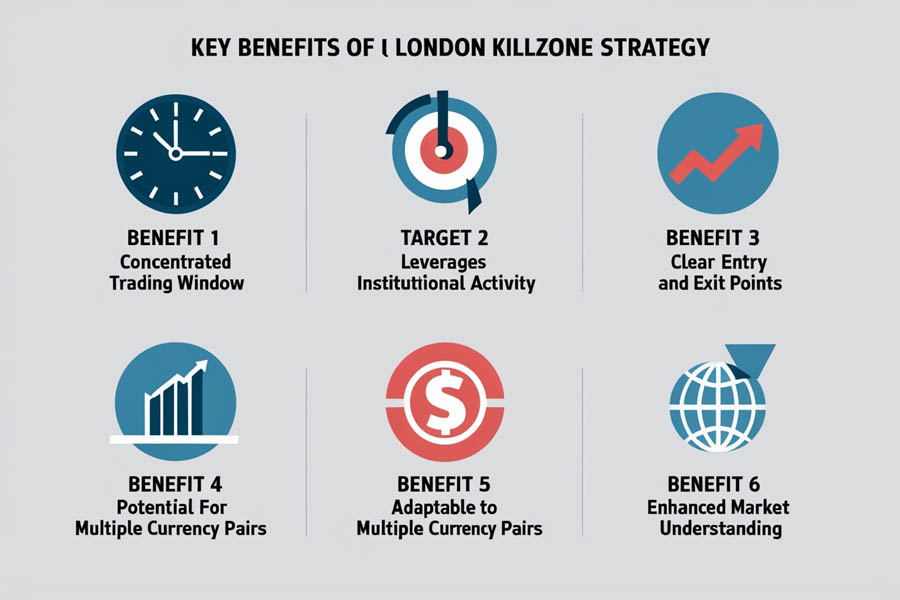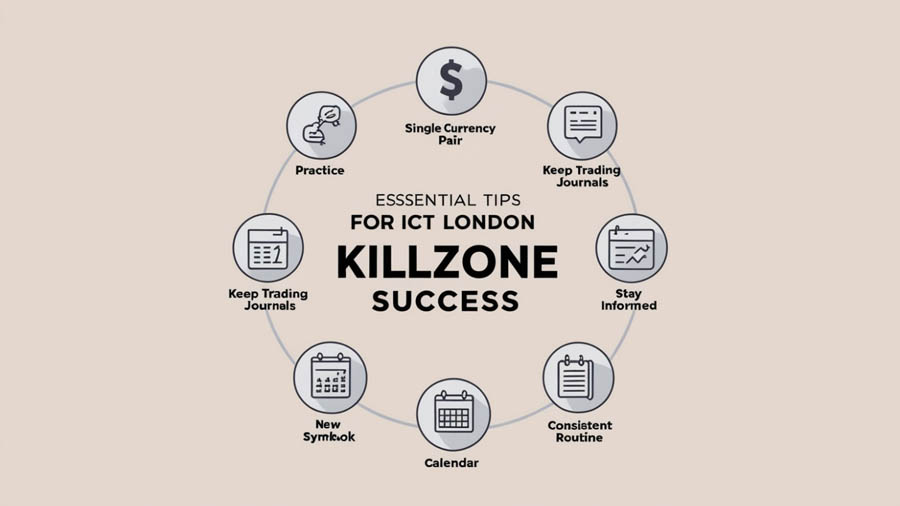The ICT London Killzone is a powerful forex trading strategy that focuses on capturing price movements during the volatile opening of the London trading session. Developed by the Inner Circle Trader (ICT), this approach helps traders align with institutional money flows to potentially generate consistent profits. By mastering the ICT London Killzone strategy, forex traders can leverage the increased market activity and liquidity that occurs when London-based financial institutions begin their trading day, typically between 2:00 AM to 5:00 AM Eastern Time. For those looking to implement this strategy, partnering with a reliable forex trading broker is essential to ensure optimal execution and access to the necessary tools and resources.

Introduction: Demystifying the ICT London Killzone Strategy
The ICT London Killzone Strategy is a forex trading method that capitalizes on the predictable patterns and institutional order flow during the London market open. This strategy, popularized by the Inner Circle Trader (ICT), provides traders with a structured approach to identify and exploit trading opportunities in the first few hours of the London session.
At its core, the ICT London Killzone Strategy involves:
- Identifying key price levels before the London open
- Anticipating potential price movements based on market structure and institutional positioning
- Executing trades with precise timing as the session begins
- Managing positions throughout the volatile first hour of trading
- Closing trades or adjusting stop-losses as the session progresses
By mastering the ICT London Killzone approach and incorporating Inner Circle Trader concepts such as order blocks, fair value gaps, and optimal trade entries, traders can potentially profit from the significant price movements that often occur during this crucial market opening period.
Understanding the London Forex Session and ICT London Killzone

The Importance of the London Session in the ICT London Killzone
The London forex session is often considered the most active and influential of all trading sessions, making it the perfect backdrop for the ICT London Killzone strategy. Here’s why:
- High Liquidity: London is the world’s largest forex trading hub, accounting for approximately 43% of global forex turnover, providing ample opportunities for ICT London Killzone traders.
- Major Currency Pairs: The most traded pairs, including EUR/USD, GBP/USD, and USD/JPY, see peak activity during this time, aligning perfectly with the ICT London Killzone strategy.
- Institutional Participation: Major banks, hedge funds, and other financial institutions (smart money) are most active during London hours, creating the volatility that the ICT London Killzone thrives on.
- Overlap with Other Sessions: The London session overlaps with both Asian and North American sessions, leading to increased volatility and trading opportunities for ICT London Killzone practitioners.
The ICT London Killzone Explained
The ICT London Killzone strategy focuses on trading during specific volatile periods, particularly around the London market open. This approach aims to capitalize on price movements that often occur during these times, often driven by smart money positioning. Traders utilizing the ICT London Killzone method monitor key price action indicators and institutional order flow to identify entry and exit points within these “kill zones” to maximize trading opportunities.
Key Characteristics of the ICT London Killzone:

- Highest volume of order execution compared to other sessions
- Opportune time for trading EUR and GBP pairs within the Killzone
- Potential for 25 to 50 pip gains during the London Open Killzone
- Tendency to create the low of the day in bullish markets and the high of the day in bearish markets within the Killzone
- Increased smart money activity, providing opportunities for savvy traders
Timing of the London Open and ICT London Killzone
Understanding the precise timing of the ICT London Killzone is crucial for successful implementation of this strategy:
- Session Start: 8:00 AM GMT (3:00 AM EST) – The beginning of the ICT London Killzone
- Peak Activity: 8:00 AM – 12:00 PM GMT (3:00 AM – 7:00 AM EST) – Prime ICT London Killzone trading hours
- Session Close: 5:00 PM GMT (12:00 PM EST) – End of the extended ICT London Killzone period

The core ICT London Killzone specifically lies between 2:00 AM to 5:00 AM Eastern Time. Traders should monitor this key time window to capitalize on the price action during the London session and maximize their ICT London Killzone strategy effectiveness.
Daylight Saving Time Considerations for ICT London Killzone Traders
During Daylight Saving Time (DST), which starts on the second Sunday in March and ends on the first Sunday in November, the timing of the ICT London Killzone shifts:
- Eastern Time is shifted one hour ahead to Eastern Daylight Time (EDT), which is UTC-4
- ICT London Killzone traders must adjust their trading schedule accordingly during DST periods to maintain strategy effectiveness
Read more: Mastering the ICT Market Maker Sell Model
The 5-Step ICT London Killzone Strategy Blueprint

To successfully implement the ICT London Killzone strategy and align with institutional movements, follow these five crucial steps, incorporating key ICT concepts:
1. Pre-Session Analysis for ICT London Killzone
Before the London session opens and the ICT London Killzone begins, conduct a thorough analysis of the market:
- Identify support and resistance levels on daily and 4-hour timeframes relevant to the Killzone
- Mark previous day’s high and low points that could impact Killzone trading
- Note weekly open prices and significant round numbers within the Killzone range
- Analyze overnight news and potential market-moving events that could affect Killzone dynamics
- Review Asian session price action for context leading into the Killzone
- Identify potential institutional accumulation or distribution zones using ICT concepts like order blocks and fair value gaps
- Look for breaches of significant highs or lows, which ICT refers to as “Breaker” zones
2. Anticipate Price Direction in the ICT London Killzone
Based on your pre-session analysis, form a hypothesis about potential price movements within the ICT London Killzone:
- Consider overall market sentiment (bullish, bearish, or neutral) and its impact on Killzone trading
- Evaluate potential impact of upcoming economic releases on the Killzone
- Analyze technical indicators suggesting overbought or oversold conditions entering the Killzone
- Study recent price action patterns and market structure relevant to Killzone trading
- Look for signs of institutional positioning, such as stop hunts or liquidity grabs, using ICT’s concept of “Optimal Trade Entry” (OTE)
- Identify potential “Mitigation” zones where price might return to before continuing its trend
3. Execute with Precision in the ICT London Killzone
As the London session opens at 8:00 AM GMT and the ICT London Killzone begins, be prepared to enter trades swiftly:
- Use limit orders to enter at predetermined levels within the Killzone
- Consider market orders for fast-moving breakouts in the Killzone
- Implement tight stop-losses to manage risk in the volatile Killzone conditions
- Look for institutional order flow signals to confirm entry points
- Utilize ICT’s concept of “Market Structure Liquid Grab” (MSLG) to identify potential entry points
- Pay attention to “Liquidity Voids” where price might move rapidly due to lack of orders
4. Ride the Momentum of the ICT London Killzone
If your trade moves in your favor within the ICT London Killzone, manage it actively:
- Scale out partial positions at predetermined profit targets within the Killzone
- Trail your stop-loss to lock in gains as price advances through the Killzone
- Add to winning positions if momentum continues strong in the Killzone
- Monitor for potential institutional reversal points using ICT’s “Institutional Candle Pattern” concept
- Look for “Fair Value Gaps” that might get filled during the price movement
5. Adapt and Close as the ICT London Killzone Progresses
As the initial volatility of the ICT London Killzone subsides, usually within the first hour, reassess your positions:
- Close trades that haven’t performed as expected in the Killzone
- Adjust stop-losses on winning trades to secure profits gained in the Killzone
- Consider holding a portion of your position if a strong trend is established beyond the initial Killzone
- Look for signs of institutional distribution or accumulation to anticipate potential reversals
- Use ICT’s “Timing Windows” concept to identify potential reversal points in time
Read more: Mastering the ICT Market Maker Buy Model
Key Benefits of the ICT London Killzone Strategy

- Concentrated Trading Window: Focus your efforts on the specific, high-opportunity timeframe of the ICT London Killzone.
- Leverages Institutional Activity: Align your trades with the actions of major market players during the Killzone.
- Clear Entry and Exit Points: Well-defined Killzone strategy reduces emotional decision-making.
- Potential for Quick Profits: Capitalize on short-term price movements within the Killzone for faster returns.
- Adaptable to Multiple Currency Pairs: Apply the ICT London Killzone strategy across various major and minor pairs.
- Enhanced Market Understanding: Develop a deeper insight into market dynamics through consistent Killzone analysis.
- Improved Time Management: Concentrate your trading efforts during the most profitable hours of the Killzone.
- Alignment with Smart Money: Increase your chances of success by trading in the same direction as institutional players.
Essential Tips for ICT London Killzone Success

To maximize your success with the ICT London Killzone strategy, consider these essential tips:
- Practice the ICT London Killzone strategy on a demo account before risking real capital
- Start with one or two currency pairs to master the Killzone strategy before expanding
- Keep detailed trading journals to refine your Killzone approach over time
- Stay informed about potential market-moving news events that could impact the Killzone
- Develop a consistent routine for pre-session Killzone preparation
- Continuously educate yourself on market dynamics affecting the ICT London Killzone
- Join trading communities or forums to share Killzone insights and experiences
- Regularly review and analyze your Killzone trades to identify areas for improvement
- Study institutional trading patterns to better understand smart money movements
Common Pitfalls to Avoid in ICT London Killzone Trading
- Overtrading: Resist the urge to enter multiple positions simultaneously within the Killzone.
- Ignoring Risk Management: Always use appropriate position sizing and stop-losses, even in the fast-paced Killzone environment.
- Chasing Missed Moves: If you miss an entry in the Killzone, wait for the next opportunity rather than forcing trades.
- Neglecting Fundamentals: While the ICT London Killzone is primarily a technical strategy, major news can still impact price action.
- Lack of Patience: Sometimes, the best Killzone trade is no trade. Wait for clear setups within the zone.
- Emotional Trading: Don’t let the excitement of the Killzone cloud your judgment. Stick to your pre-defined plan.
- Failing to Adapt: Market conditions change. Be prepared to adjust your Killzone strategy if it’s not performing as expected.
- Ignoring Smart Money Signals: Pay attention to institutional order flow and don’t trade against strong smart money movements.
Advanced Techniques for Seasoned ICT London Killzone Traders
As you become more comfortable with the basic ICT London Killzone strategy, consider incorporating these advanced techniques:
Multi-Pair Correlation Analysis in the Killzone
- Study correlations between currency pairs to confirm trends within the Killzone
- Look for divergences that might signal potential reversals as the Killzone progresses
Order Flow Analysis for Enhanced Killzone Trading
- Incorporate order flow data to gauge institutional buying and selling pressure in the Killzone
- Use volume profile tools to identify key areas of interest within the Killzone range
Integration with Other Trading Methodologies
- Combine the ICT London Killzone strategy with other proven approaches like Elliot Wave Theory or Fibonacci retracements
- Develop a comprehensive trading system that leverages the Killzone alongside other profitable strategies
Advanced Smart Money Concepts
- Implement order block analysis to identify potential reversal points
- Use liquidity theory to anticipate where smart money might be looking to fill large orders
Read more: Mastering the ICT London Open Strategy
OpoFinance: Your Trusted Partner for ICT London Killzone Trading
When implementing the ICT London Killzone strategy, having a reliable and regulated broker is crucial. OpoFinance, an ASIC-regulated broker, offers traders the perfect platform to execute this powerful strategy. With tight spreads, fast execution, and a robust trading infrastructure, OpoFinance ensures that you can capitalize on every opportunity the ICT London Killzone presents.

OpoFinance provides:
- Advanced charting tools for precise Killzone analysis
- Rapid order execution to catch fast-moving markets within the Killzone
- Competitive spreads on major currency pairs favored by Killzone traders
- 24/7 expert customer support for round-the-clock assistance
- Educational resources to enhance your ICT London Killzone trading skills
Conclusion: Elevate Your Forex Trading with ICT London Killzone Mastery
The ICT London Killzone strategy offers a powerful framework for traders looking to capitalize on one of the most dynamic periods in the forex market. By following the five-step blueprint, incorporating smart money concepts, and adhering to sound risk management principles, you can potentially unlock consistent profits and elevate your trading career through mastery of the ICT London Killzone.
Remember, success in forex trading requires dedication, continuous learning, and disciplined execution. The ICT London Killzone strategy is not a guaranteed path to riches, but rather a tool that, when used correctly, can significantly enhance your trading arsenal and potentially lead to more consistent profitability.
Are you ready to take your forex trading to the next level? Start implementing the ICT London Killzone strategy today, and experience the potential of aligning your trades with institutional market movements during one of the most volatile and opportunity-rich periods in the forex market.
Can the ICT London Killzone strategy be used during other trading sessions?
While the ICT London Killzone strategy is specifically designed for the London session due to its high liquidity and institutional activity, some principles can be adapted to other sessions. However, the effectiveness may vary, as different sessions have distinct characteristics and volatility patterns.
How do I know if a trade setup within the ICT London Killzone is valid?
A valid trade setup within the ICT London Killzone typically aligns with key market structure concepts, such as order blocks, fair value gaps, or institutional order flow. Confirmation signals, like a break of market structure or a liquidity grab, can further validate the setup. It’s essential to combine these with your pre-session analysis and market sentiment to determine validity.
What are the most common mistakes beginners make with the ICT London Killzone strategy?
Beginners often make the mistake of overtrading, failing to adhere to strict risk management, and chasing missed moves within the Killzone. Another common error is ignoring the broader market context, such as fundamental news or macroeconomic trends, which can significantly impact price action during the Killzone.







